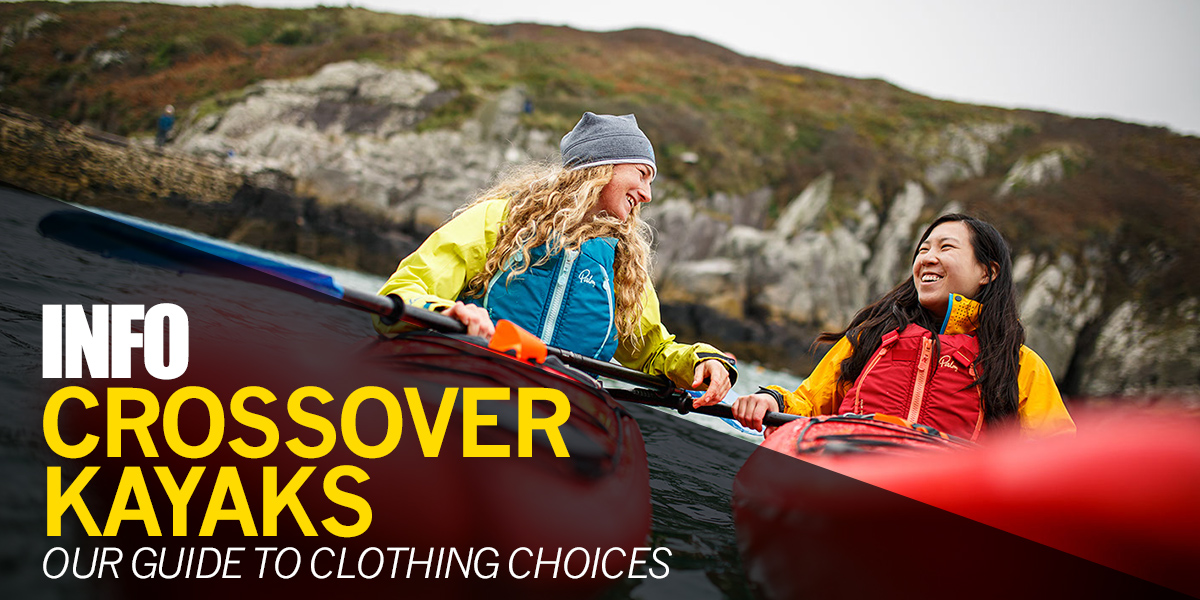‘There's no such thing as bad weather, only inappropriate clothing’
A statement that has been quoted many times in relation to hill walking, yet remains equally applicable to paddle sports. The correct attire can transform your enjoyment on the water and even extend your season by many months. Some of our favourite days on the water have been cold, crisp winter ones. Fewer people on the water gives a feeling of serenity, as well as potentially encouraging more wildlife to venture out. However, while we’re here to advise on the best clothing combination for cold weather it’s equally important to consider hot summer days and the potential effect of falling into chilly water. In this blog we address these questions in relation to closed cockpit crossover kayaks such as the Pyranha Fusion and Dagger Katana, making recommendations that strike the right balance of performance and price. One thing to bear in mind with closed cockpit models is that your lower half is protected, especially when using a spraydeck, and this could tempt you to wear thinner layers. However, it should not lead to complacency as ultimately the water will still be cold should you fall in.
In theory, it is possible to break the discussion down into first layer, technical layering and accessories.
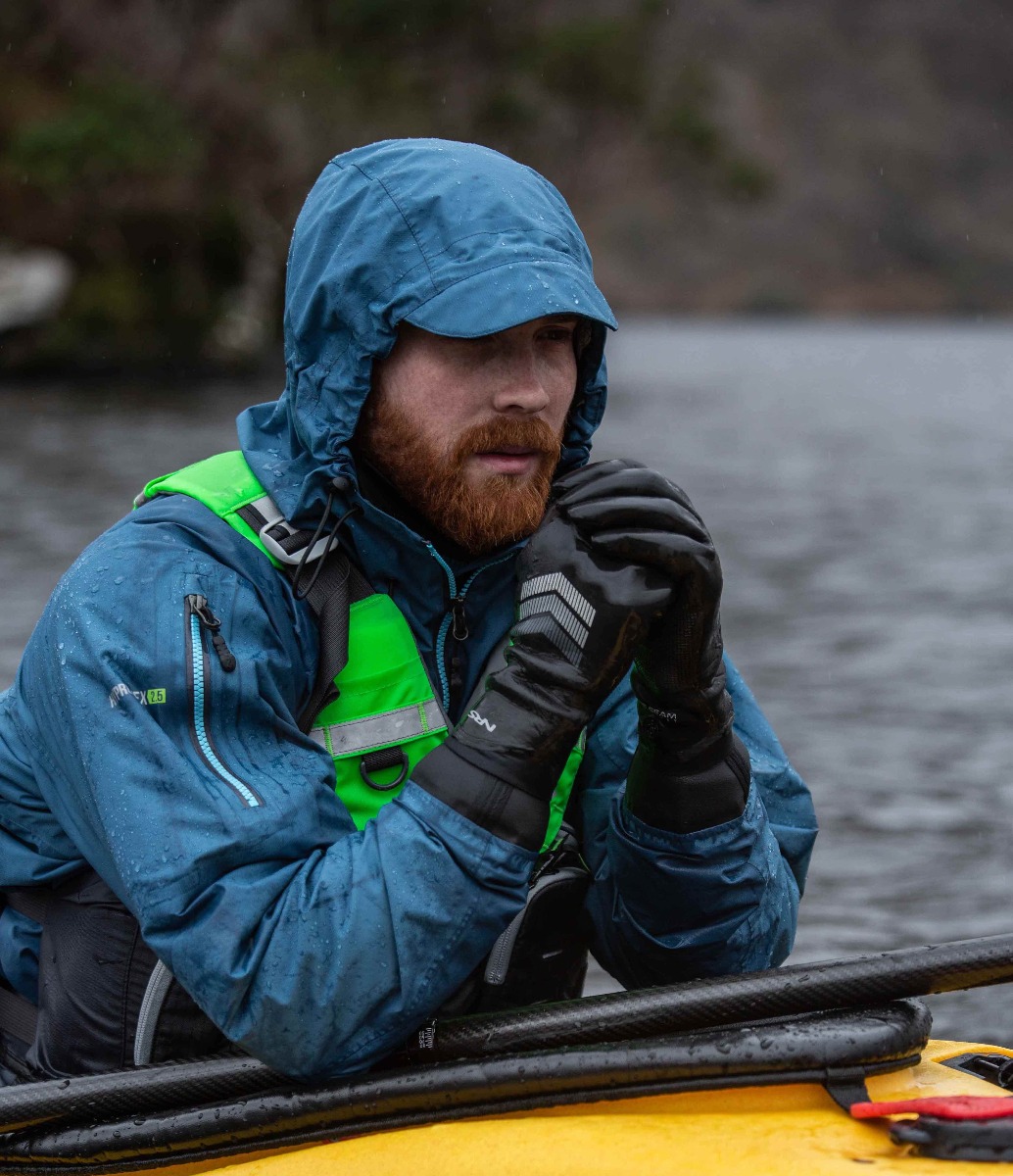
FIRST LAYERS
We treat the first layer as fabrics that contact your skin. Our favourite configurations include:
Full Wetsuit – For cold days full wetsuits are an excellent choice, offering total body coverage. Once in the water, a wetsuit is excellent for heat retention, trapping a thin film of water against the skin. The downside is that when not immersed the rubber fabric lacks the breathability of woven alternatives and can feel more restrictive due to the skin tight fit. For kayaking we recommend 3-4mm as the best balance of warmth and flexibility. Glued seams are an excellent idea, ensuring that if you fall in very little cold water will enter the suit.
Long John Wetsuit – Like the idea of a wetsuit but prefer something a little less restrictive? In this case a long john wetsuit is your dream purchase. They give thermal insulation in the body and legs, while leaving your arms completely free. As you would imagine, the repetitive action of kayaking makes freedom of movement extremely important. Don’t forget that if using a long john you will need a thermal top before considering technical outer layering.
Neoprene Pants – Still finding the long john a little too much? Paddling in warmer months? Wetsuit pants are a brilliant idea in that they are super simple to get into but still provide warmth. Your lower half is much more likely to get wet due to paddle splash or sitting on a wet seat so it is definitely a good idea to wear water specific trousers even on warm days. As with the long john, you will massively benefit from a thermal top when using neoprene pants.
Thermal trousers – It is rare you would use thermal trousers in isolation. These are more likely to be worn in conjunction with a technical layer such as dry trousers or drysuit.
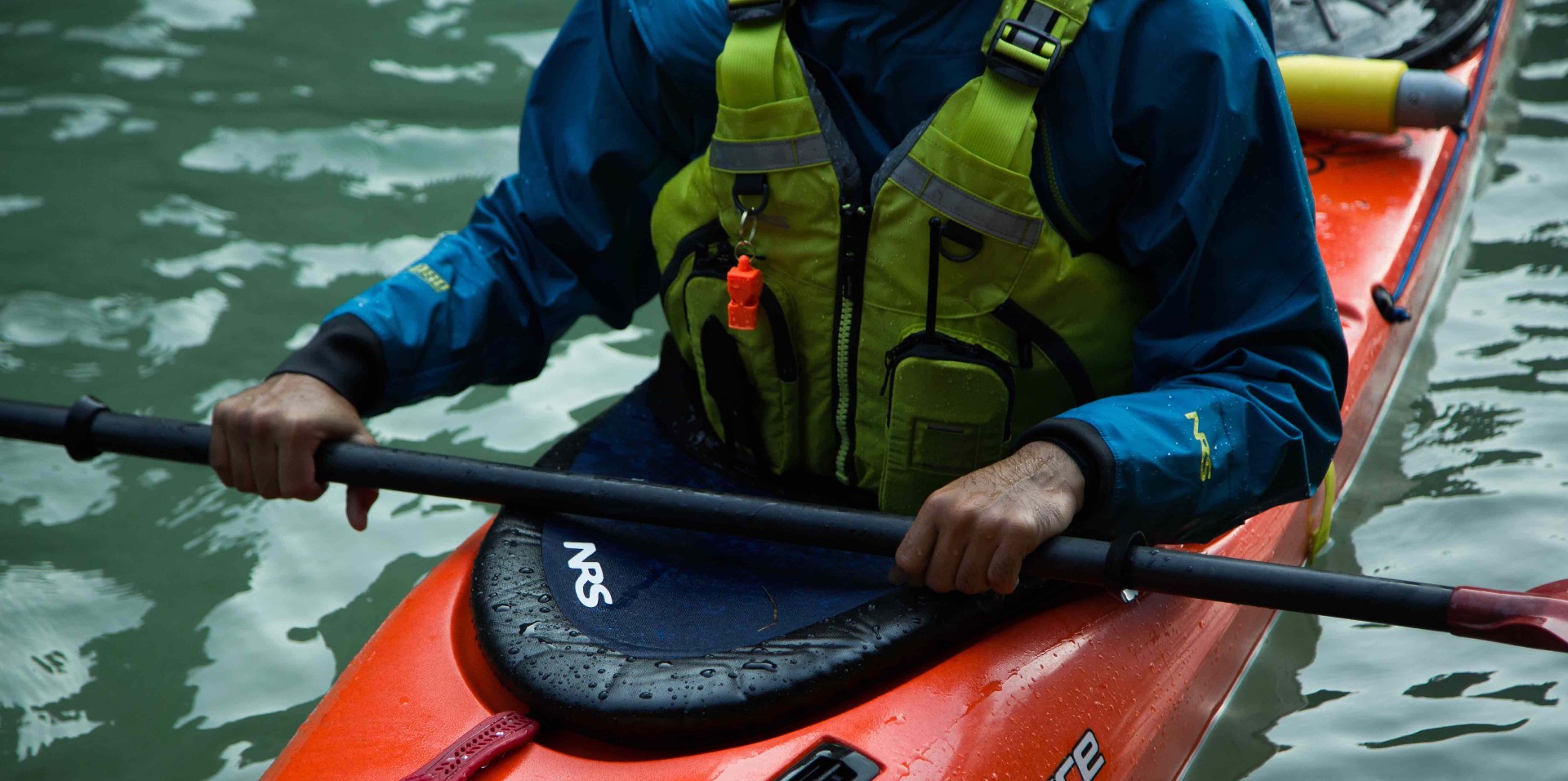
TECHNICAL LAYERING
When we refer to technical layering it relates to splash jackets and pants. As a general rule these will be made of laminated fabrics in a similar way to walking clothing. Such materials are lightweight, waterproof and breathable. A major benefit is that they are wind proof and the benefit of this, especially when wet, should not be underestimated. The most common piece of technical clothing you are likely to wear is a dry cagoule. There is much to learn in this area, so please read on for more information.
Dry Cags
When waterproof jackets are developed for paddle sports the design is quite different to those tailored towards walking or mountain biking. The benefits of choosing a jacket that is specific to kayaking are:
- An improved cut. A shorter body avoids bunching at the waist when in a seated position. There will be more material under the arms to give absolute freedom of movement when paddling.
- Neck & Wrist Seals. On the water we wear a spray jacket to stay dry and thus having seals on the wrist and neck is important. Simple jackets use a velcro tab to achieve this, while more performance orientated choices involve neoprene or latex cones. Latex ultimately creates the best seal but having such a tight fit around the neck can be uncomfortable for long days and is thus best reserved for cold days or when paddling in turbulent water where you are likely to get wet. However, our staff kayakers are a massive fan of latex on the wrists given you are much more likely to end up with hands in the water and won’t enjoy cold flush up the forearm.
When choosing a splash jacket other things to consider are features such as hoods, pockets and twin waists:
- Hoods – incredibly useful in poor weather but can be a pain in windy conditions. Look for models than can be cinched down or tucked away into a small pocket
- Pockets – many of our customers find these useful but the location is critical. We’re fans of positions that will be covered by the buoyancy aid. Shoulders are a brilliant place for a pocket but don’t put anything heavy in these as you really notice it when paddling. Ideal for drinks money though. Non alcoholic if paddling home of course!
- Twin waists on cags are extremely important for kayaks types that use a spraydeck, allowing you to integrate these for a drier experience. Whether you choose to use a spraydeck with your crossover kayak is personal preference but is definately beneficial once you are comfortable to do so. As such, plan ahead and look to twin waist models if you like to future proof.
The final thing to be aware of is that not all waterproof fabrics are created equal. Looking at the number of layers gives you a good idea of the quality. Most will be rated 2, 2.5, 3 or 4 layers and as a generalisation the higher this number the better.
The kayak waterproof jackets we stock normally have a minimum of two layers and this is the traditional approach of specialist fabric manufacturers. The outer layer is visible, the one you see when looking at a jacket on the shelf. This forms the main structure of the garment and gives the look and feel, as well as abrasion resistance. The inner layer, or membrane, is an invisible layer and is where all of the magic happens, turning an ordinary piece of fabric into one which is both waterproof and breathable. The downside to pure two layer fabrics is that the internal waterproof membrane is exposed and can therefore be worn away through use. You should avoid using rough base layers or those with zips for this reason. To reduce the potential for damage, 2.5, 3 and 4 layer fabrics use a progressively higher quality additional inner layer to protect your valuable waterproof membrane (layer 2).

Dry Trousers
Much of the same discussion is possible with dry pants, most notably the choice of 2, 3.5, 3 or 4 layer fabrics. Other areas to consider are as follows:
- braces or no braces. We’re a massive fan of braces on dry trousers as they eliminate the potential for the pant to ride down, which can lead to a chilly gap between top and bottoms. However, you will normally find that female specific models don’t include braces for obvious reasons.
- Socks or seals? The all important question and one we have strong opinions on. Dry Trousers can have no ankle seals, a neoprene or latex cone, or fully integrated dry sock. Moving along this spectrum sees increasing budget. The vibe from our staff kayakers is that when conditions dictate use of a dry trouser the word dry is critical and thus you should choose models with integrated socks. After all, there is nothing worse than a long day with cold wet feet after launching your boat.
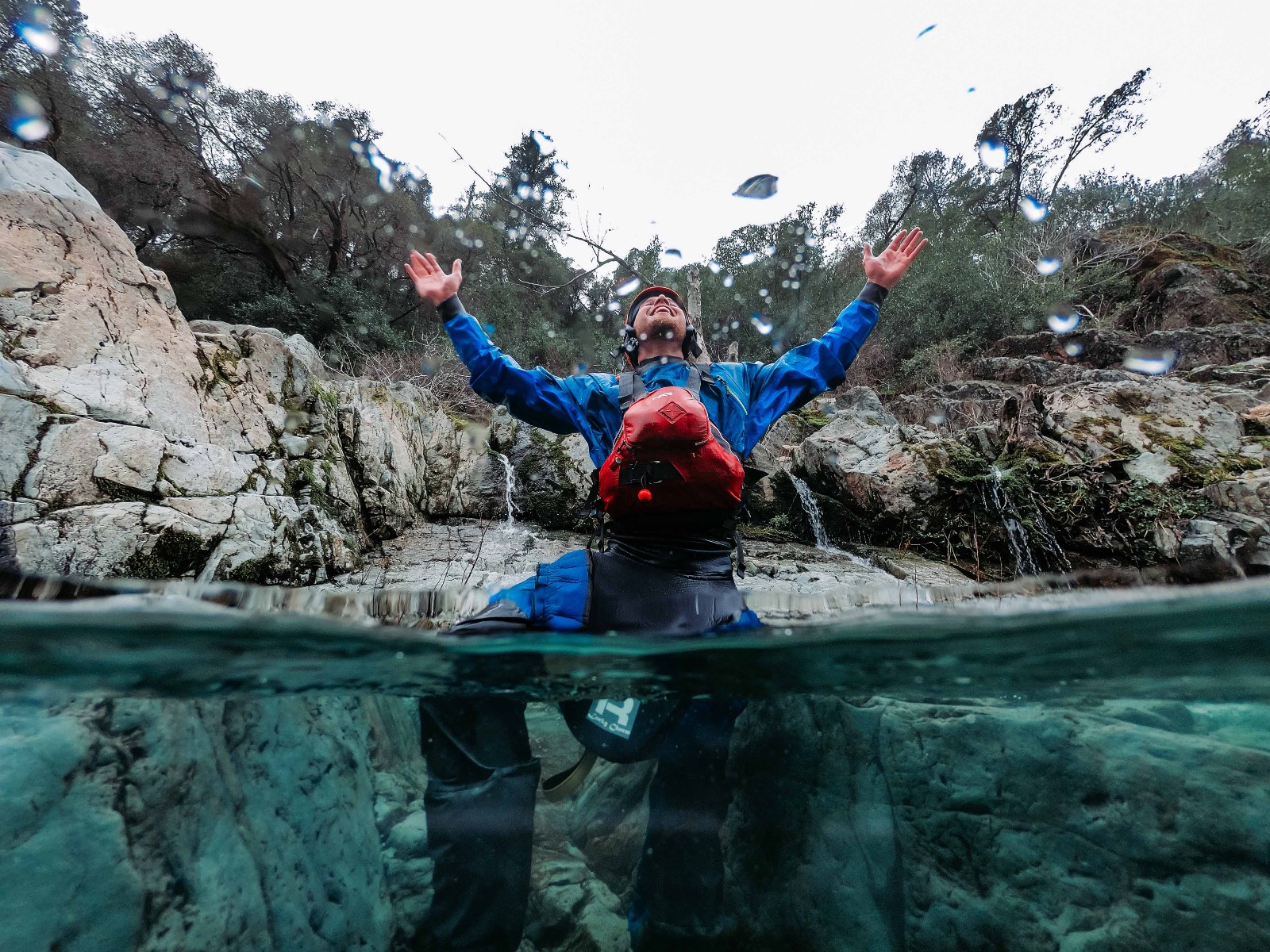
(technical layering making all the difference)
Classic Combinations
The beauty of these separate layers is the ability to vary your clothing choice to suit conditions on the day. We hope the information has proved useful and the combination that works for you is ultimately the right choice. Here are just two potential choices for all round and cool conditions.
Warm Weather Warrior – late spring through early Autumn
Neoprene Pants
Light Weight long sleeve thermal top
Splash Jacket (ft. tab seals)
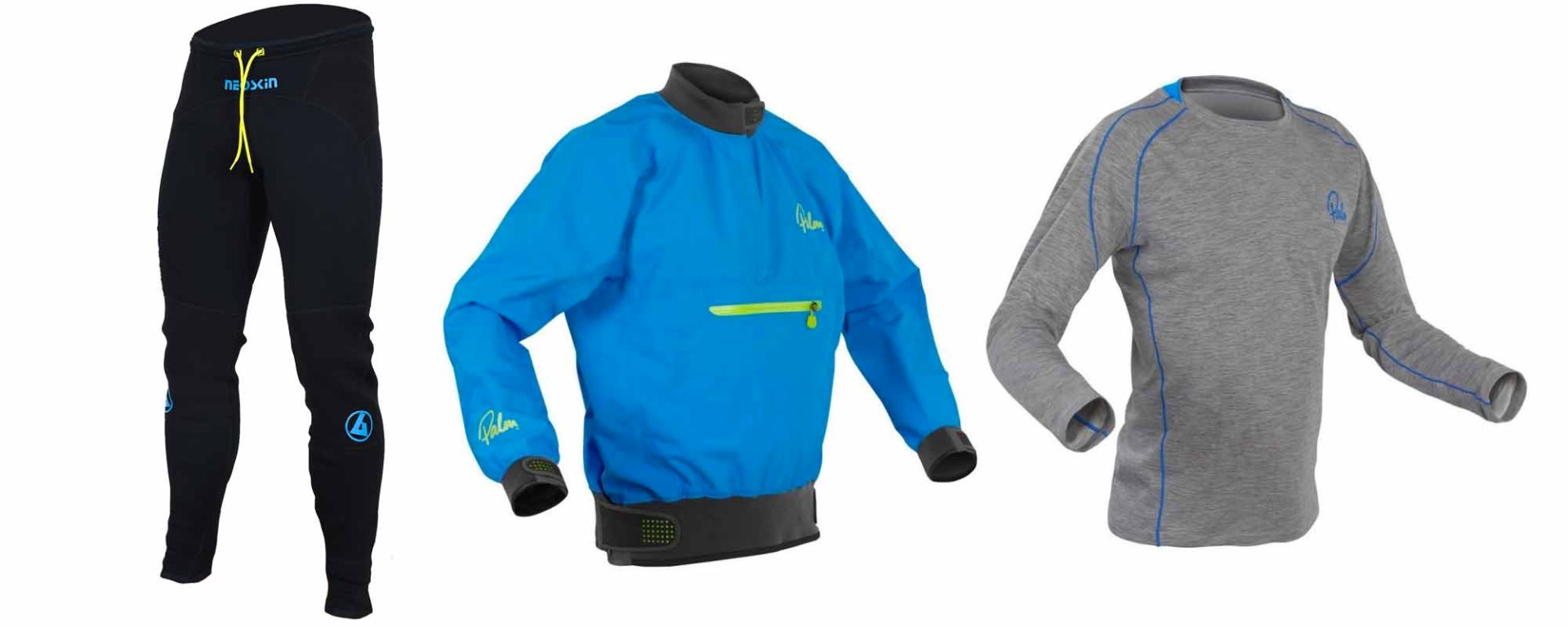
The All Rounder – early spring through late Autumn
Long John Wetsuit
Mid Weight long sleeve thermal top
Hooded Splash Jacket (ft. tab seals)
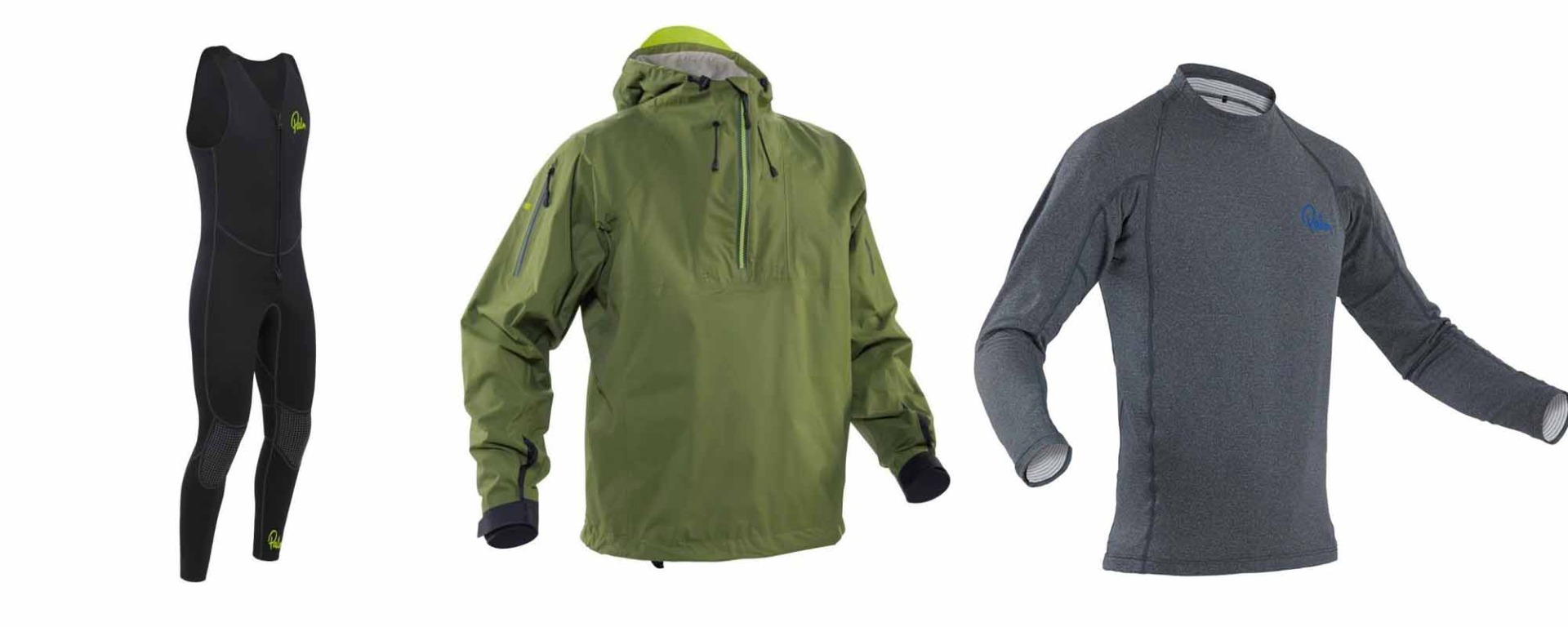
Pushing your limit – All but the coldest days
Mid weight thermal suit
Dry Jacket (ft. neoprene cone wrist seals)
Dry Pants (ft. integrated dry socks)
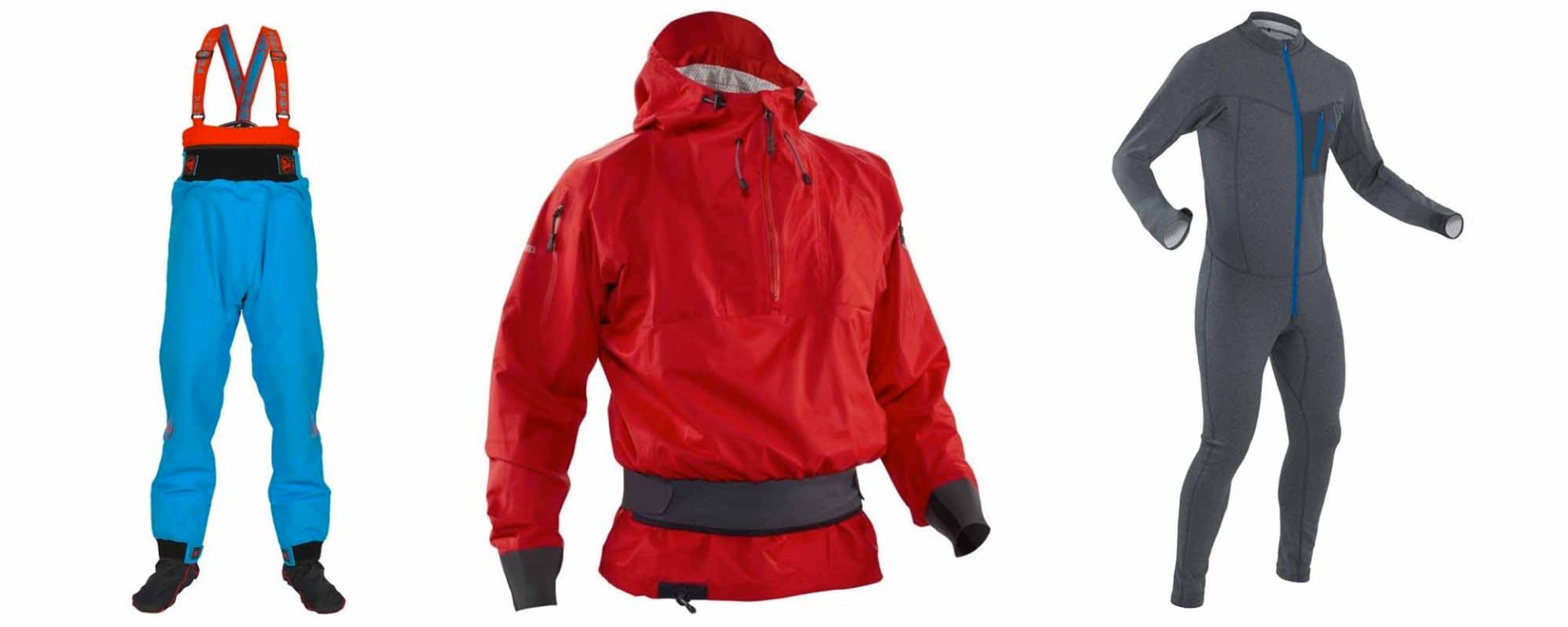
ACCESSORIES
Once you clothing selection is confirmed it is time to consider accessories, namely those for feet, hands and head.
Feet
The footwear you select should fulfil two roles, warmth and protection. Warmth will come from neoprene and increasing the thickness from 3 to 5mm will make a big difference. Also look out for thermal linings as they provide further benefit. Boots designed for surfing will have a thin sole to give excellent feel of the board. However, this is useless when carrying kayaks over rough ground and thus a medium to thick sole is generally preferable. Laces or Velcro straps help provide a more secure fit but don’t forget you are unlikely to be walking miles before getting into the boat. If choosing a high cut neoprene boot we would recommend these have a zip or laced opening to make them easier to get on and off. Some of our customers favour a trainer style water shoe but it will be useful to know these give little thermal insulation and thus the use of an additional neoprene sock is preferable.
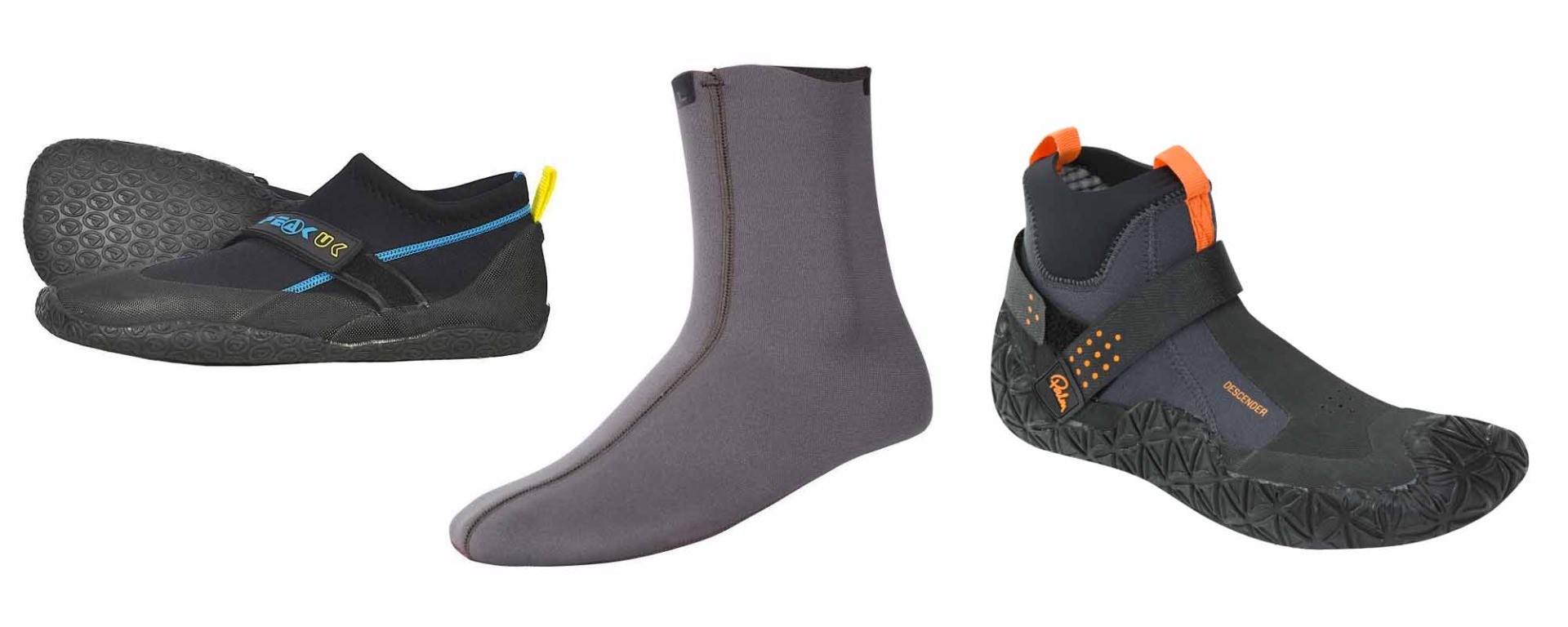
(popular footwear styles from Peak UK, NRS and Palm)
Hands
Choosing what to wear on your hands is perhaps the ultimate challenge. Yes, it is nice to be warm but thick gloves are a kayakers enemy, reducing paddle feel. Models made from 5mm spongy neoprene will cause you to grip harder than normal so as to achieve the desired connection and this tends to result in forearm cramp. As such, we recommend 2-3mm gloves as striking the perfect balance of warmth and feel. Glued seams are helpful in keeping more cold water out. Some models will be precurved to match the natural profile of a hand gripping the paddle. However, in our experience this is not critical with thin flexible gloves in the 2-3mm range.
There are variants away from the traditional glove, most notably the open palm mitt, which leaves a gap in the palm to ensure you retain the perfect connection with your paddle. Pogies achieve a similar thing, being a mitt that directly attaches to the paddle. Simply slide your hands in for protection from the wind and additional warmth due to their neoprene construction.
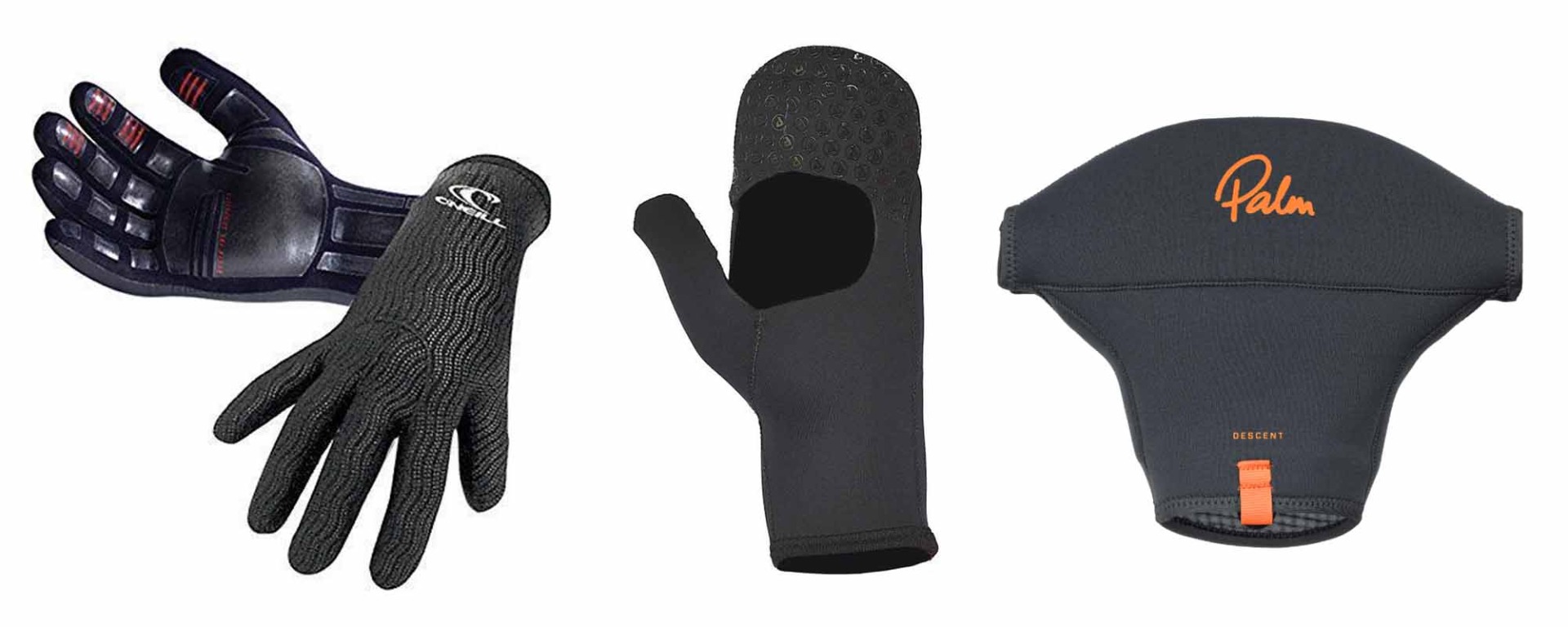
(gloves, open palm mitts and pogies)
Head
Headwear is an interesting debate because the scenario differs massively depending if you will wear a helmet or not. If the answer is yes, you are well protected from the cold but it can be useful to add a thin neoprene cap underneath. This will need to be under 3mm thick so as not to affect the helmet fit. If you’re paddling flat water and choose not to wear a helmet then a wool beanie or similar is fine. However, be aware that a rain shower will quickly ruin the benefit and thus neoprene alternatives are arguably superior. In the summer time the effect of the suns UV rays are multiplied when reflected from the water surface. It is important to protect your skin with cream or an appropriate brimmed hat.
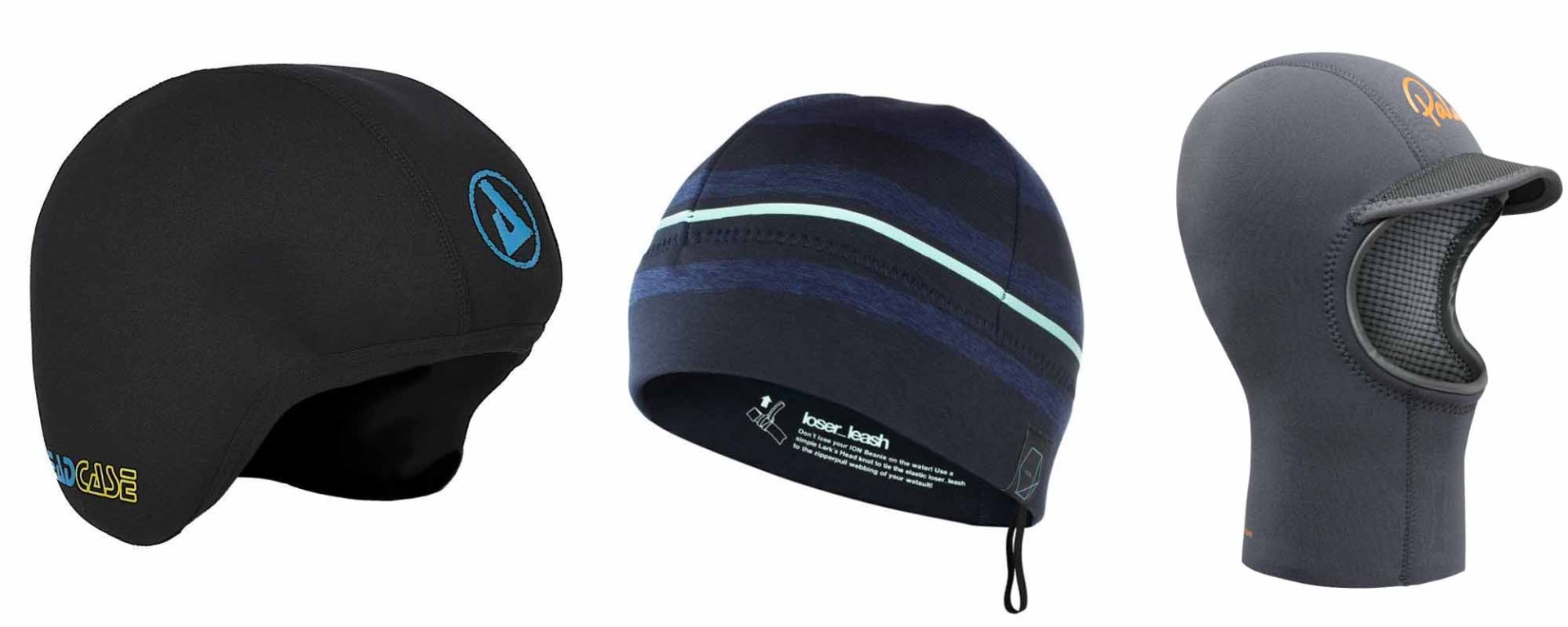
(neoprene helmet liner, beanie and full hood)
CONCLUSION
Having appropriate clothing will transform your time on the water and extend your days, as well as season more generally. It need not cost the earth and in many cases is extremely versatile, with seperate tops, trousers and thermals allowing you to choose the right combination for your day.
We hope this general advice has been useful but there is nothing quite like gaining the view of our expert staff. Why not get in touch today on 01924 444888 or via the following link for advice.















